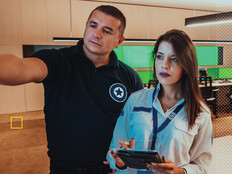Efficiency Experts
When the Georgia Coastal Regional Commission (CRC) decided its call center agents in the aging services department needed desktop replacements, it cast traditional computing to the wind and embraced client virtualization instead.
With client virtualization, also known as desktop virtualization, desktop images are housed, managed and secured centrally, then served up as virtual instances on user computing devices as needed. Early adopters are realizing a number of benefits from the technology, says Laura Hansen-Kohls, a senior research analyst with Info-Tech Research Group. The benefits are mostly operational in nature, including centralized patching and upgrading, rapid provisioning and decommissioning of desktops, and an extended useful life for legacy hardware, she says.
In Georgia, for example, the IT staff can better support the CRC call center agents serving the elderly now that it uses client virtualization, says Brandon Westberry, chief technology officer for the CRC, one of several regional planning commissions created under Georgia law and managed by local governments. The CRC, headquartered in Brunswick, Ga., serves 10 counties and 35 cities.
"The majority of their work is web-based, plus some basic Word and Excel, so computing-wise the call center agents' needs aren't very extensive," Westberry says. "When it came time to get new computers, we looked around for less costly, more efficient alternatives."
A Natural Fit
Fresh off a successful server virtualization project, Westberry says his thoughts naturally turned to virtualization technology at the client level. On top of that, he'd already begun researching how the CRC might use thin client computing. The two were a natural fit for the department as it sought to refresh its desktop computers.
To provide greater efficiencies, the CRC decided to outfit call center agents with thin clients and deliver up their desktops from a central location using Citrix XenDesktop client virtualization software with XenServer on the back end.
Since that initial 12-user implementation a year ago, the CRC has expanded the use of virtualized clients into the agency's Planning and Government Services Department. Today some 20 users have virtual clients, a number that Westberry says will double shortly as the CRC also rolls out client virtualization to call center agents handling transportation services.
Westberry estimates that virtual clients save his organization roughly $400 per user, and more for users who require high-performance desktops. Thin clients running virtualized desktops have also reduced the organization's power usage. "We're pulling a maximum of seven watts, which is considerably less than we were pulling with desktop computers," he says.
In addition, IT has become far more efficient. "We've cut the amount of time spent on PC-related help desk issues by more than half," Westberry says.
"We can do everything from the server," adds Simon Howard, an IT technician with the CRC. "And as far as things that end users can break -- well, we've taken that out of the picture. If they accidentally delete or corrupt files, that image can be obliterated and they can start fresh every time."
The new desktop management efficiencies also give IT staff a lot more time to spend on other critical projects, Westberry says.
"We've found better ways of doing things that we didn't have time to research before because we were always running around helping users with random desktop problems," he says. "For example, I've found ways to save a considerable amount of money on our phone bills."
Streamlining IT
Client virtualization does indeed reduce the time and effort required to support user desktops, agrees David Nero, director of infrastructure and technology for the city of Boston. For the pilot phase of a VMware View client virtualization implementation, 50 members of one city department have received virtual desktops on thin clients.
"The primary benefit for us as an IT organization is the fact that we can do what we need to do without having to visit a machine," Nero says. "Being able to serve up a desktop with everything that's needed is a really efficient support model."
Doug Young, CIO for the state of Missouri, says he also sees improved IT support as one of client virtualization's greatest boons. In Missouri, the IT organization has been pilot testing VMware View with approximately 400 users for about one year, and soon will bring on another 1,000 or so clients, he says.
"Desktop virtualization is providing a pretty big advantage for us over our traditional practice of having to send a technician onsite when it comes to patching, fixing problems and keeping desktops up to date," Young says. "We'd gotten away from some of that through remote desktop operations, but we believe the virtual desktop approach will really lessen our need for physical support staff as we go forward. This next 1,000 users will help me tell the story on what that ratio will be."
User productivity should also get a boost from client virtualization, Young says. With client virtualization, state employees will be able to use personal devices for work purposes without worrying about security.
"We'll be able to squirt desktops out to private PCs and not be too concerned about what nasty things might live on those because we're controlling that virtual environment," he explains. "When the users get done, we just terminate the connection. Since data was not transferred, we don't have the same fear we had of getting infected by viruses or malware when we let somebody's machine onto the network through a VPN."
Wiping Away Security Concerns
Kurt Plowman, chief technology officer for the city of Staunton, Va., has an interesting metaphor for the security efficiencies gained through client virtualization. The city uses VMware vSphere client together with a specialized thin client virtual machine manager for patron use at the public library.
41,000
The number of desktops within Missouri state government, the bulk of which CIO Doug Young says he believes could be virtualized
"Each patron comes up and gets a brand-new Kleenex. When they're done, they throw it away. Nobody wants to use a Kleenex that somebody else has just used, so every Kleenex looks the same but is fresh and clean and ready to use," Plowman says.
"That's just what we've done with desktop virtualization in the library. Every patron sits down, gets full administrative rights and can do anything they want with that desktop -- they can install software, load malware, run junkware. When they're done, the system reboots and all of that is completely gone. The next patron sits down and gets a fresh desktop," he adds.
This allows Staunton IT staff to run a more stable platform, and the library system can serve its patrons in a more efficient, secure manner, Plowman says.
As Info-Tech's Hansen-Kohls adds, "IT is always looking for new ways to prove its value to the business, and desktop virtualization really opens up that opportunity. It gives IT the ability to spend more time tackling strategic IT goals rather than on help desk support."
Implementation Advice
Are you considering deploying client virtualization? Heed these recommendations from the experts:
Seek outside help. Even if your staff is quite capable, consider engaging a third party to help with the deployment, suggests
Doug Young, CIO for the state of Missouri. "You can avoid some of the pitfalls and mistakes if you work with a company that's in the business of assisting with implementations and can help with the how-to," he adds. "If we'd have done that, we could have moved our pilot stage along more quickly than we were able to do learning the lessons ourselves."
Think beyond the pilot test. "As departments move into proof-of-concepts and start to scale out to more and more people, they're realizing that they need more storage and bandwidth along with other things that didn't come up in the pilot program," warns Laura Hansen-Kohls, senior research analyst for Info-Tech Research Group. "So you have to think about scalability: What happens when you send this out to everybody and not just the 10 people you're doing the pilot with? Pilot tests are necessary, but don't consider them a significant indicator of success."
Consider a hybrid
approach. Running graphically intense programs such as AutoCAD or Adobe Photoshop on a virtual client can be "a bit tricky," Hansen-Kohls says. Run those applications locally for high performance, while using client virtualization to serve up standard office and productivity applications from a central site, she advises.
Look toward the future. "If we can get to the point where the virtual desktop is truly a good, workable solution that removes some of the security concerns around letting people use personal devices at work -- and as those security concerns get removed -- then I have to start taking a hard look at procurement, inventory, repair, replacement and maintenance practices," Young says. "So if we have virtual desktops available and somebody wants to bring in an iPad, then I might be able to say, 'OK, bring it on in,' and going forward, provide a more user-friendly environment for state workers."







